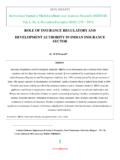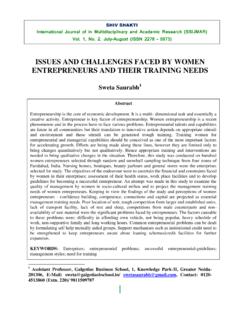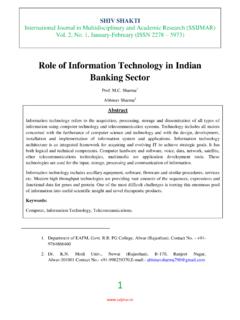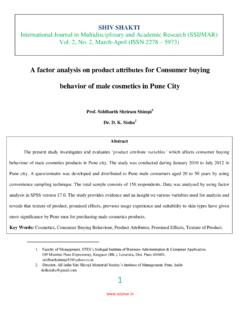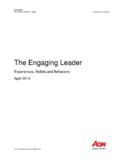Transcription of Assertive Leadership and Employee Engagement …
1 1 Assertive Leadership and Employee Engagement And its Impact on Retention Richa N Agarwal * *Asstt. Prof. ITS Institute of Management SHIV SHAKTI International Journal in Multidisciplinary and Academic Research (SSIJMAR) Vol. 1, No. 4, November-December (ISSN 2278 5973) Abstract - The organization world over are going through various changes and challenges. One of the major uphill task in front of organizations is to retain best talents as well as to keep them motivated enough to give their best performance.. it is said that people join the company but leave the boss. The author has tried to research the role of Leadership and impact of Engagement on the retention of the employees.
2 The author have focused on the Assertive Leadership role in engaging and retaining the employees. The research is focusing on the problem across the industries and is based on the secondary data. In the current unstable economy where organizations are becoming more complex and the competitive landscape to retain the talents is becoming more threatening; Assertive Leadership model is stressing on the Leadership style where the leader is loving , mentoring and nurturing the employees but at the same time he or she is not so weak to be dominated by the employees , norms or culture. 2 Assertive Leadership and Employee Engagement And its Impact on Retention Introduction - Googling the word Leadership generates 439 million search results.
3 Leadership is undoubtedly the most talked about, referenced, researched or analyzed subject, whether within or outside management literature many people today are seeking to understand and many people are writing about the concept of practices of Leadership . There are many reasons for the popularity of the topic, including that organizations are faced with changes like never before. The concept of Leadership is relevant to any aspect of ensuring effectiveness in organizations and in managing change. Leadership is not only used to motivate employees for better performance, to adopt new behaviours, values and attitudes (Daft and Marcic, 2001.) But now days it is one of the most important tool against the war of talent.
4 As the slowdown of economies world over has impacted the organizations, retaining best players will be difficult and it is becoming a leader s top priority. Money is not the answer: money is only one driver in terms of retention. Employee Engagement on the other hand is multi dimensional and companies need to weigh compensation, work life balance, professional development programmes and other factors which contribute to job satisfaction. A study conducted by Mckinsey and company in 1997, dubbed as the war for talent predicted that the most important corporate resource over the next 20 years would be talent: smart, sophisticated business people.
5 Subsequent surveys in 2006 and 2007 further reaffirmed the trend and revealed that finding and retaining talented people was the single most important managerial preoccupation Organizations are also recognizing the fact that it is also about attracting and retaining the right people . Employees are an asset only when their work values are in alignment with 3 organizational purpose and when they are emotionally and intellectually engaged with organizational objectives Engagement is a deep and broad connection that employees have with a company, resulting in a willingness to go above and beyond what s expected of them to help their company succeed.
6 IEngagement is a relevant metric, as it correlates highly to performance. We hear a lot about the Engagement today, for good reason. According to the right management, 84 % of the (disengaged) workforce is considering looking for a new job. ISR research reports that high Engagement companies declined over 12 months. What kind of Engagement an Employee is going to have depends on the leader and Leadership style. Research Methodology The research is based on the secondary data available in various Business magazines, journals related to Leadership . After intensive and extensive reading author has drawn some relation with the Leadership and Employee Engagement which has a bearing on Employee attrition.
7 Review of literature Atwater, Leanne e. have examined the extent to which changes in leader behavior is related to changes in Employee attitudes. The results indicated that improved subordinate ratings of the leader on consideration, performance orientation, and Employee development related to increased subordinate Engagement and satisfaction as well as reduced intentions to leave. This study demonstrates that improved leader behavior following 360-degree feedback is related to improved Employee attitudes. Julie Gebauer and Don Lowman writes in Engagement Gap that most leaders have yet to harness the power of Engagement , failing to achieve the 4 performance lift that a fully engaged workforce can deliver.
8 While most people regularly say they want to give more to their companies , only a fifth of the global workforce in our recent study is currently fully engaged .-------- Engagement is a deep and broad connection that employees have with a company , resulting in a willingness to go above and beyond what s expected of them to help their company succeed . Harsh Dwivedi and Smita Choudhary says that Leadership style is the pattern of behaviours engaged in by the leader when dealing with employees. Dr Bannerjee and Sujaya says the flip side of a high growth economy is that Leadership positions have become easily available to anyone who is half prepared for the job -----someone who can lead the business for now risking the organizations culture, talent development and retention expecting support functions like HR to take on an unfair load of Leadership responsibility Gary Hamel quips as a student of management, he is depressed that so many people find work depressing (only 20 % of employees are engaged in their work heart and soul.)
9 P. Premlatha has examined factors impacting voluntary turnover such as job satisfaction, organizational commitment, job involvement and individual s performance are identified as independent variables; alternate employment opportunities as moderating variable; and behavioral intentions to quit as intermediate linkage in impacting voluntary. She has presented a conceptual framework of voluntary turnover by identifying and examining the relationship among the major determinants, moderating factor and intermediate linkage Sheridan & Vrendenburgh, 1978; Ribelin, 2003;Eisenberger, Stinglhamber, Vandenberghe, Sucharski, Ivan & Rhoades, 2002;Rhoades, L.
10 , Eisenberger, R., & Armeli, S. (2001) are of the opinion that Leadership and relationships play a key role in organizational success. Recent 5 research on the association between Employee satisfaction and job performance suggests that the single most important contributor to the feelings of Employee Engagement , empowerment and satisfaction is based on the relationship they have with the leaders of the organization. Joe Folkman says however those leaders who focus on their own Leadership effectiveness can actually boost Employee satisfaction and commitment. In the word of Wellin and Jim (2005), Engagement means passion , commitment , extra efforts.
